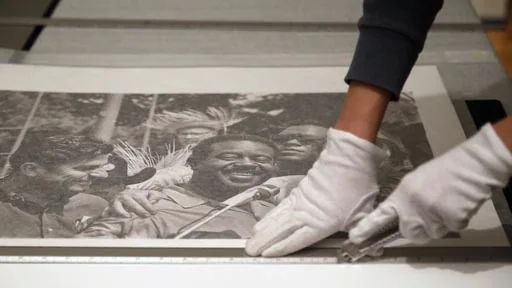
Russell Contreras | Associated Press
ALBUQUERQUE, N.M. (AP) — Mexican-American photographer Maria Varela was present at some of the most dramatic moments of the Civil Rights Movement, capturing images of voting rights demonstrations in Alabama and efforts to create Head Start programs in poor, rural areas.
As one of the few Latinas involved in the black Civil Rights Movement, historians say, her work has often been overlooked.
Now the National Museum of Mexican Art in Chicago is set to feature 28 images from the Albuquerque resident’s rarely seen photography of the movement at an exhibition called “Time to Get Ready: Fotographía Social.”
“You can tell she wasn’t just someone who dropped in and photographed what happened. She was part of what was happening,” said Cesareo Moreno, the museum’s visual arts director.
Moreno said the exhibit will cover Varela’s work from Mississippi marches and voting rights battles to photographs she took of Chicano activists fighting to get Spanish land grants recognized in New Mexico.
In 1963, the Chicago-raised Varela was recruited by the Student Nonviolent Coordinating Committee, a key organization in the movement, to work in Selma, Alabama, for a voter literacy program. A local sheriff arrested its staff and broke up the program.
Varela was then reassigned to Mississippi where organizers told her to develop training materials.
After training with noted photographer Matt Herron in New Orleans, Varela grabbed a camera and built her own dark room in Mississippi since local drug stores likely would refuse to develop her film. She dressed in a skirt and a head scarf and tried to remain invisible while she took photos.
The images she captured were meant to be part of informative booklets passed out to farmers, town residents and parents who were working to resist segregation and poverty. She created pamphlets to train activists to build political campaigns and develop farming co-ops.
Her photos illustrated an autobiography of civil rights activist Fannie Lou Hamer.
“A lot of times I wasn’t thinking. I was just shooting,” she said. “Other times, I was zeroing in on strong faces … people with determined expressions.”
As news of her work spread, SNCC assigned Varela to various marches and demonstration. Organizers felt law enforcement officers would be less likely to beat protesters if there were more cameras, Varela said.
One of her assignments was to capture images of the 1966 “March against Fear” in Mississippi, an event created by activist James Meredith to encourage blacks to register to vote. But Meredith was gunned down by a sniper on the second day of the march.
That prompted SNCC and Dr. Martin Luther King Jr.’s Southern Christian Leadership Conference to join and continue the march. It was during this event that historians believe Stokely Carmichael shouted the phrase “black power.”
Though Varela rarely took photos of the famous civil rights leaders like King, she noticed King, Carmichael and Andrew Young leading the crowd. The three leaders weren’t smiling. “They clearly looked burdened. They looked thoughtful and pensive,” she said. So, she snapped the shot.
Less than two years later, King was dead.
Varela would photograph Cesar Chavez and the United Farm Workers, New Mexico land grant leader Reies Lopez Tijerina and the organizing meetings leading to the 1968 Poor People’s Campaign, a march King planned to draw attention to poverty.
Brian Behnken, a history and Latino studies professor at Iowa State University, said historians likely had a problem placing Varela in the context of the Civil Rights Movement because she was a Mexican-American documenting conflict between whites and blacks.
“It has taken a while, but I think she’s being appreciated more now,” Behnken said. “She was way ahead of her time.”
Moreno said artists today can learn from Varela and how she used her photography to tell stories of people often overlooked. “She was literally walking along history,” Moreno said. “And her work is tender and honest.”
The exhibit will run March 3 to July 30 at the National Museum of Mexican Art in Chicago.
___
Follow Russell Contreras on Twitter at http://twitter.com/russcontreras. His work can be found at http://bigstory.ap.org/content/russell-contreras.
Copyright 2017 The Associated Press. All rights reserved. This material may not be published, broadcast, rewritten or redistributed.
